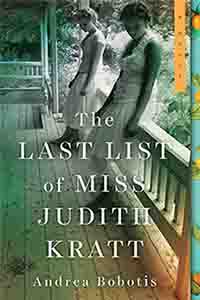“Andrea Bobotis is a new, original voice as Southern as they come! In The Last List of Miss Judith Kratt, she unravels a complicated web of dirty Southern secrets. Using masterful writing and a perfectly calculated reveal of damaged history, she ends up weaving a tapestry that is so much more.”
NO MAJOR SPOILERS
An impressive debut, The Last List of Miss Judith Kratt is an accomplished piece of storytelling. The year is 1989 and 75 year old Judith Kratt has decided to create an inventory of all the Kratt family property and valuables with the help of her live in companion Olva, whom she has known since childhood.
Along with the antique furniture and family silver she has inherited a tragic family secret that she is hoping to take to the grave. As she goes through the house cataloguing it’s contents ,she is drawn back in time to 1929 , the year her brother Quincy was tragically killed.

The story proceeds in two timelines as Judith tells her story. In 1929 she is terrified of her father, the rich and autocratic Daddy Kratt, who rules the household with a rod of iron, and at times a riding crop as we learn later in the book, while in 1989 her comfortable life is shattered by the arrival of her long estranged sister Rosemarie.
As Rosemarie begins to force her to really examine her bias and attitude to those she regards as her social inferiors, we learn of how the complex relationships between races in the era she grew up in may have formed those biases in the first place. As the secret at the heart of the book is slowly revealed and we see the damage it has caused to more than one family, damage that has lingered to the current day it becomes impossible to put the book down.
Besides the well crafted plot and impeccable prose, this book also has an array of wonderfully developed characters . From the crusty and crotchety Judith to free spirit Rosemarie, to the sneaky but sometimes loyal Quincy, and of course not forgetting the truly terrifying patriarch, the Kratt family is certainly a memorable one and the dynamics between the characters , in both eras, always feels authentic.
I particularly loved the complicated relationship between Olva and Judith, one which it is impossible for the reader to understand until the end of the book, but when you get there it makes so much sense. I also liked the way the book explored race relations in both time periods, and showed how much progress has been made in some ways and how little in others, this added an interesting extra dimension to the book as a whole.
The author did a really great job of bringing both time and place to life, the setting in a former cotton town almost leaps off the page in certain passages.
Reviewed by:
Annette Jordan
Added 10th September 2019

